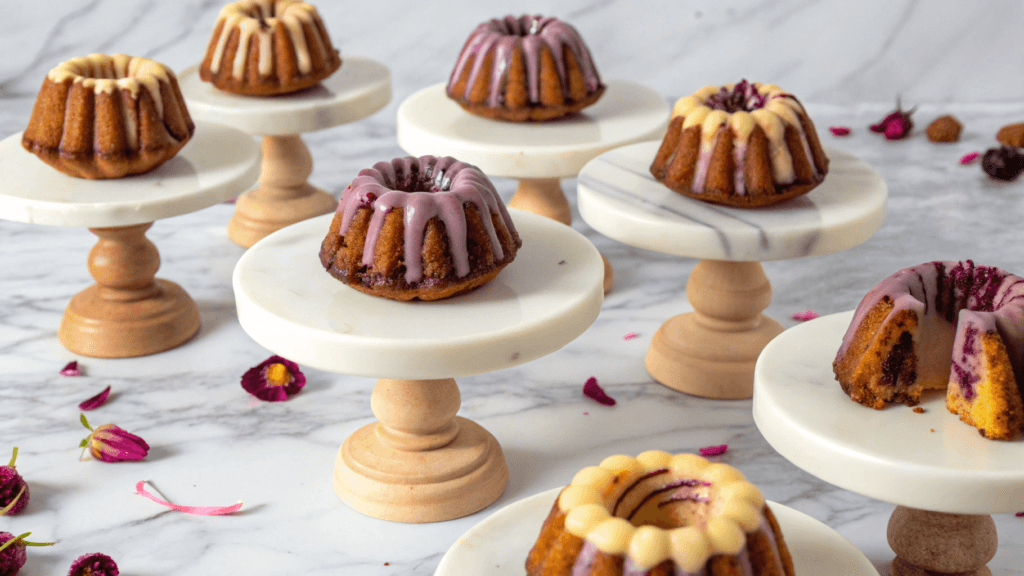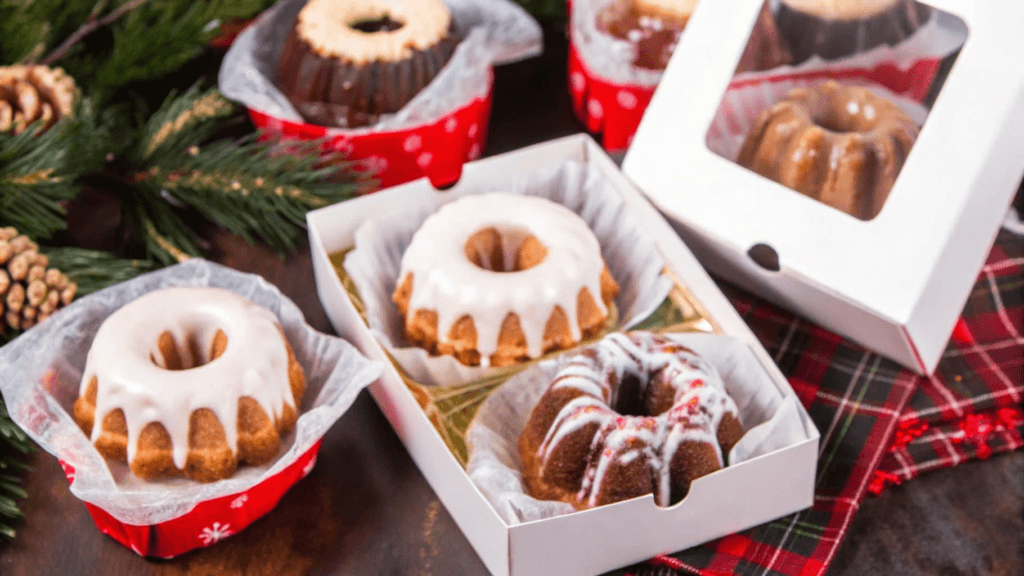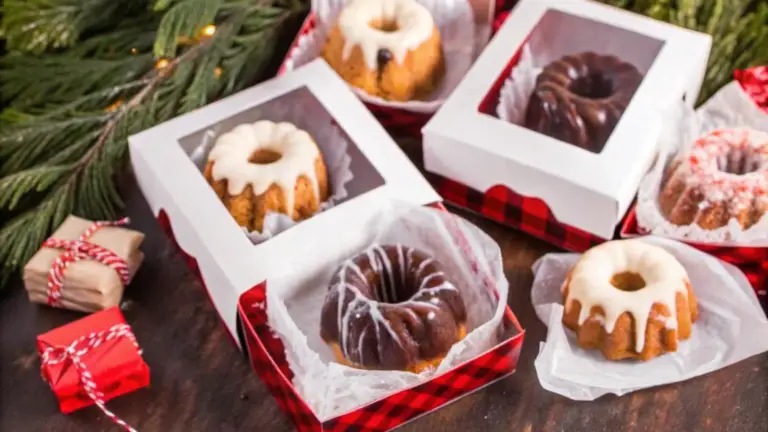Mini bundt cakes are a charming choice, perfect for a quick snack or an elegant celebratory dessert. But like all baked goods, their freshness has a limit. This article unpacks everything you need to know about keeping mini bundt cakes fresh for as long as possible. We’ll explore the factors affecting their shelf life, provide optimal storage tips, and show you how to identify signs of spoilage. Whether baking at home or savoring a store-bought cake, you’ll find valuable insights to make the most of your mini bundt cake experience.
Factors That Affect the Freshness of Mini Bundt Cakes
Ingredient Choices and Their Impact on Shelf Life
The ingredients in mini bundt cakes significantly affect how long they stay fresh. Cakes made with perishable ingredients like fresh fruits, cream cheese, or heavy cream will spoil faster than those relying on shelf-stable components like flour, sugar, and butter. For example, a cake with a cream filling may need refrigeration within hours, while a simple vanilla mini bundt cake can last days at room temperature.
Moreover, preservatives often found in store-bought mini bundt cakes can prolong their shelf life compared to homemade versions. If you’re baking at home, natural stabilizers like lemon juice or vinegar can help extend the cake’s freshness without compromising flavor.
Environmental Conditions and Their Role in Cake Longevity
The environment where you store your mini bundt cakes also matters. A warm and humid setting can speed up spoilage by encouraging mold growth or moistening cakes. On the other hand, storing your cakes in a cool and dry area helps preserve their texture and taste.
If cakes are left uncovered in such environments, they will dry out within hours. Proper storage, like wrapping them in plastic or keeping them in airtight containers, can shield them from air exposure, reducing the risk of staleness or contamination.
Comparison of Homemade vs. Store-Bought Mini Bundt Cakes
Homemade and store-bought cakes differ not only in taste but also in shelf life. Store-bought options often include packaging designed to retain moisture and prevent spoilage. Additionally, preservatives extend their shelf life significantly—sometimes lasting up to a week at room temperature.
While fresh and flavorful, homemade mini bundt cakes usually lack these enhancements. They require careful storage and typically last 3–4 days at room temperature. Freezing can help preserve homemade cakes for longer periods.
How Long Mini Bundt Cakes Stay Fresh Under Different Conditions

If you’ve ever wondered how long mini bundt cakes will stay fresh, the answer varies depending on whether they’re frosted or plain. Unfrosted mini bundt cakes can last about 3–5 days at room temperature when stored properly. To keep them fresh, ensure they’re covered with plastic wrap or stored in an airtight container to prevent them from drying out.
Room-temperature storage isn’t ideal for cakes with perishable toppings like cream cheese frosting or whipped cream. These should be refrigerated promptly to avoid spoilage. A frosted mini bundt cake might last 1–2 days on the counter before losing its texture or freshness.
Store the cakes in a cool, dry place away from direct sunlight for best results. Humidity and heat can quickly ruin the taste and structure of these delightful desserts.
In the Refrigerator
When stored in the refrigerator, mini bundt cakes can stay fresh for up to a week. This is particularly helpful for frosted or cream-filled cakes, which need cooler conditions to maintain quality. However, refrigeration can cause cakes to dry out if not appropriately wrapped.
To preserve freshness, wrap the cakes tightly in plastic or aluminum foil. For added protection, could you place them in a sealed container? This prevents them from absorbing odors from other foods in the fridge, which could compromise their flavor.
It’s worth noting that cakes with glazes or sugary toppings often fare better at room temperature unless the glaze contains dairy. In that case, refrigeration is your best bet.
In the Freezer
Freezing is a fantastic way to extend the shelf life of mini bundt cakes, allowing them to stay fresh for up to three months. Before freezing, wrap each cake tightly in plastic wrap, followed by a layer of aluminum foil. This double layer of protection prevents freezer burn and keeps the cakes tasting their best.
For added convenience, label the wrapped cakes with the frozen date. When you’re ready to enjoy them, thaw the cakes at room temperature for a few hours. Avoid microwaving them directly, as it can affect the cake’s texture.
Freezing works well for unfrosted cakes, but frosting may separate or become grainy after thawing. If you plan to freeze a frosted cake, choose buttercream frosting, which holds up better during freezing and thawing.
Proper Storage Tips for Maximum Freshness
Choosing the Right Containers
Keeping mini bundt cakes fresh starts with selecting the proper storage containers. Airtight containers are your best friend for maintaining moisture and flavor. If you don’t have one, a sealed freezer bag can work just as well. Just be sure to remove as much air as possible before sealing.
Plastic wrap or foil can also help, but ensure they’re applied tightly around the cake to prevent air exposure. Avoid using loose covers, which won’t protect the cake from drying out or picking up odors.
Techniques for Wrapping Cakes Effectively
Proper wrapping is essential for mini bundt cakes stored at room temperature or in the fridge. Use plastic wrap to cover the cake completely, ensuring no air can seep. Then, add a layer of foil for extra protection. For frosted cakes, consider placing them on a plate before wrapping them to keep the frosting intact.
If freezing, individually wrap each cake before placing it in a freezer-safe bag or container. This prevents cakes from sticking together and makes thaw only what you need easier.

Avoiding Common Storage Mistakes
Some storage mistakes can ruin even the most delicious mini bundt cakes. One standard error is leaving the cakes uncovered. This allows air to dry them out and makes them susceptible to contamination. Another frequent mistake is refrigerating cakes without wrapping, which causes them to absorb fridge odors or become stale.
Storing cakes in high-humidity areas can also lead to sogginess or mold growth. Always check the conditions of your storage space and adjust as needed to keep the cakes fresh.
Recognizing Signs of Spoilage
Visual Indicators
Visual inspection is one of the easiest ways to determine if your mini bundt cakes have spoiled. Mold growth is a clear sign that the cakes are no longer safe to eat. This often appears as surface green, white, or black spots. Discoloration, such as the frosting turning darker or the cake developing a dull, grayish hue, is another indicator of spoilage.
Dryness or cracks forming on the surface can signal that the cakes have lost their moisture and freshness. The cake may no longer be enjoyable if the glaze or frosting looks separated or grainy.
Changes in Texture and Smell
Spoiled mini bundt cakes often undergo noticeable texture changes. A fresh cake should be soft and moist, but it may have dried out if it feels rubbery or crumbly. Cakes with fillings can show spoilage through a curdled or slimy consistency.
The smell is another critical factor. If the cakes emit a sour, off-putting odor instead of their usual sweet aroma, they’vethey’ve likely gone bad. Always rely on your senses to evaluate the condition of the cakes before consuming them.
Safe Disposal Practices
Once you’ve identified spoilage, it’s essential to dispose of the cakes safely. Wrap them in a sealed bag before discarding them to prevent contamination or attracting pests. Never consume a cake if you suspect it has gone bad even a tiny amount of mold or spoilage can cause foodborne illness.
If you’re interested in similar treats, check out this article on Mini Bundt Cakes Recipes & Tips for fresh inspiration.
Frequently Asked Questions About Mini Bundt Cakes
How Long Will Mini Bundt Cakes Stay Fresh on the Counter?
If stored correctly, mini bundt cakes typically last 3–5 days at room temperature. Unfrosted cakes can be left out longer than those with perishable frostings or fillings, which should ideally be refrigerated after a few hours to maintain their freshness.
Can Mini Bundt Cakes Be Frozen to Extend Freshness?
Yes! Freezing is an excellent way to preserve the freshness of mini bundt cakes for up to three months. Wrap each cake tightly in plastic wrap and foil, then place them in an airtight container. Thaw them at room temperature for a few hours before serving.
How Can I Revive Slightly Stale Mini Bundt Cakes?
If your cakes feel dry, a quick microwave zap (10–15 seconds) can restore some of their moisture. Alternatively, adding a fresh glaze or drizzle of syrup can enhance their flavor and texture.
What Are the Best Storage Practices for Mini Bundt Cakes?
Always store mini bundt cakes in airtight containers or tightly wrapped in plastic to prevent air exposure. Refrigeration is recommended for frosted or cream-filled cakes, while room temperature works for plain or glazed varieties.
Comparing Mini Bundt Cakes and Cookie Cakes
Key Differences in Shelf Life
When comparing mini bundt cakes to cookie cakes, the shelf life of each varies significantly due to their ingredients and structure. Mini bundt cakes, with their moist texture and often perishable frostings, can stay fresh for 3–5 days at room temperature, provided they are correctly stored. In contrast, cookie cakes, which are denser and often less moist, can last longer up to a week without refrigeration—since they contain fewer perishable ingredients.
However, storage methods significantly affect both types of cakes. For instance, covering mini bundt cakes tightly prevents them from drying out, while cookie cakes benefit from airtight containers to maintain their chewy texture.

Which Is Easier to Store?
Storing cookie cakes is generally more straightforward than mini bundt cakes. Their flat, sturdy structure makes them less prone to damage during storage. Simply wrapping them in plastic wrap or placing them in a cookie tin ensures they stay fresh. Mini bundt cakes, on the other hand, often require extra care to avoid squishing their delicate shapes or damaging frosted decorations.
Both mini bundt cakes and cookie cakes perform well when frozen. However, mini bundt cakes with frosting may experience texture changes upon thawing, while cookie cakes retain their quality more consistently.
Pairing Mini Bundt Cakes and Cookie Cakes for Events
Why Both Cakes Are Perfect for Celebrations
Mini bundts and cookie cakes have unique qualities that make them excellent event options. Mini bundt cakes are visually stunning, often adorned with frosting, glazes, or decorative toppings that can match any theme. Cookie cakes, on the other hand, are versatile crowd-pleasers that can be customized with messages or designs.
Pairing the two creates a dessert table with various textures and flavors. Guests who prefer a softer, moister dessert can opt for mini bundt cakes, while those who enjoy the chewy sweetness of a giant cookie can indulge in the cookie cake.
Storage Tips for Multi-Cake Events
Proper storage is essential to ensure freshness when serving both mini bundt cakes and cookie cakes at an event. To protect their delicate shapes, keep mini bundt cakes in individual containers or on a covered platter—meanwhile, store cookie cakes in tins or trays wrapped in cling film until serving time.
To add variety, consider offering different flavors of both types of cakes. For example, a chocolate chip cookie cake pairs wonderfully with vanilla mini bundt cakes. This combination satisfies various tastes and adds a delightful touch to your event.
How to Use Leftover Mini Bundt Cakes Creatively
Transforming Leftovers Into New Desserts
How long will mini bundt cakes stay fresh, and how will they be used before they spoil? Leftovers can easily be turned into fresh, creative desserts. Crumble the cakes into bite-sized pieces to make a trifle. Layer the crumbs with whipped cream, custard, and fruit for a visually stunning and delicious dessert. This works exceptionally well with mini bundt cakes that are slightly dry or past their peak freshness.
Alternatively, you can create cake pops by mixing the crumbled cake with some frosting, shaping it into small balls, and coating them in melted chocolate. These are a hit at parties and an excellent way to minimize waste.
Incorporating Leftovers Into Breakfast or Snacks
Leftover mini bundt cakes can also make a delightful breakfast. Slice the cake into thin layers and toast them lightly. Spread butter or jam over the slices for a quick, indulgent treat. For a more adventurous twist, use the slices as a base for French toast, soaking them in egg mixture and pan-frying until golden brown.
If you’re looking for a snack, cut the cakes into cubes and bake them into crunchy croutons. These sweet croutons pair perfectly with a yogurt parfait or a bowl of vanilla ice cream.
Why Proper Storage Matters for Mini Bundt Cakes
Preserving Quality and Flavor
Proper storage is crucial to answering the question, “How long will mini bundt cakes stay fresh?” When stored correctly, these treats retain their moisture, texture, and flavor for several days. Cakes left uncovered or in improper conditions, however, can quickly lose their appeal, becoming stale or hard.
Using airtight containers or wrapping the cakes securely protects them from drying out and absorbing unwanted odors. Additionally, maintaining the right temperature ensures the ingredients—especially perishable fillings or frostings—stay fresh and safe to consume.
Reducing Food Waste
Understanding how to store mini bundt cakes properly helps reduce food waste, especially when you’ve baked or bought more than you can eat right away. Freezing leftover cakes can extend their shelf life by months, giving you the flexibility to enjoy them later. This is especially helpful for busy families or anyone hosting events.
If you’re concerned about sustainability, repurposing leftover cakes is a simple yet effective way to prevent waste. Whether transformed into a new dessert or enjoyed as a snack, leftovers can be given a second life with minimal effort.
Practical Tips for Maintaining Freshness
Label your storage containers or freezer bags with dates to track how long the cakes have been stored.ini bundt cakes remain as delightful as when they were first made.
Always cool cakes entirely before wrapping or storing them to prevent condensation, which can lead to sogginess.
For frosted or glazed cakes, place parchment paper over the surface before wrapping to protect the decoration.
Label your storage containers or freezer bags with dates to track how long the cakes have been stored.

